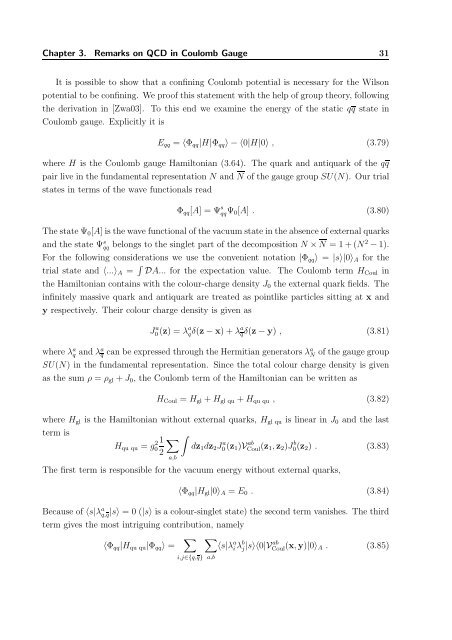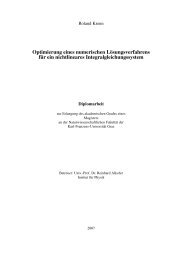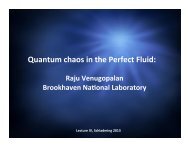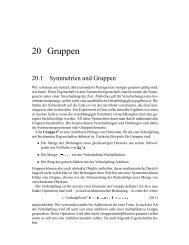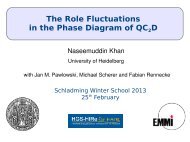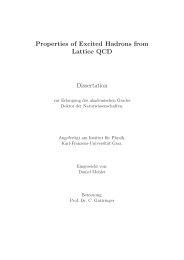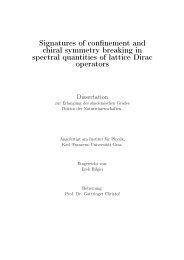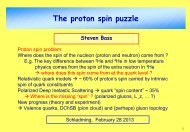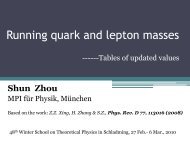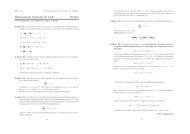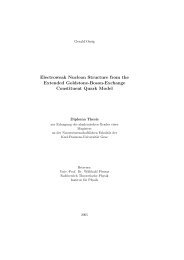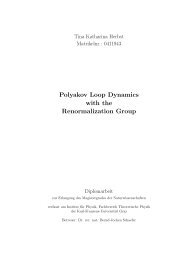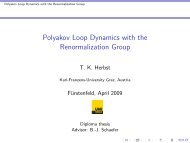The QCD Quark Propagator in Coulomb Gauge and - Institut für Physik
The QCD Quark Propagator in Coulomb Gauge and - Institut für Physik
The QCD Quark Propagator in Coulomb Gauge and - Institut für Physik
You also want an ePaper? Increase the reach of your titles
YUMPU automatically turns print PDFs into web optimized ePapers that Google loves.
Chapter 3. Remarks on <strong>QCD</strong> <strong>in</strong> <strong>Coulomb</strong> <strong>Gauge</strong> 31<br />
It is possible to show that a conf<strong>in</strong><strong>in</strong>g <strong>Coulomb</strong> potential is necessary for the Wilson<br />
potential to be conf<strong>in</strong><strong>in</strong>g. We proof this statement with the help of group theory, follow<strong>in</strong>g<br />
the derivation <strong>in</strong> [Zwa03]. To this end we exam<strong>in</strong>e the energy of the static qq state <strong>in</strong><br />
<strong>Coulomb</strong> gauge. Explicitly it is<br />
E qq = 〈Φ qq |H|Φ qq 〉 − 〈0|H|0〉 , (3.79)<br />
where H is the <strong>Coulomb</strong> gauge Hamiltonian (3.64). <strong>The</strong> quark <strong>and</strong> antiquark of the qq<br />
pair live <strong>in</strong> the fundamental representation N <strong>and</strong> N of the gauge group SU(N). Our trial<br />
states <strong>in</strong> terms of the wave functionals read<br />
Φ qq [A] = Ψ s qqΨ 0 [A] . (3.80)<br />
<strong>The</strong> state Ψ 0 [A] is the wave functional of the vacuum state <strong>in</strong> the absence of external quarks<br />
<strong>and</strong> the state Ψ s qq belongs to the s<strong>in</strong>glet part of the decomposition N × N = 1 + (N 2 − 1).<br />
For the follow<strong>in</strong>g considerations we use the convenient notation |Φ qq 〉 = |s〉|0〉 A for the<br />
trial state <strong>and</strong> 〈...〉 A = ∫ DA... for the expectation value. <strong>The</strong> <strong>Coulomb</strong> term H Coul <strong>in</strong><br />
the Hamiltonian conta<strong>in</strong>s with the colour-charge density J 0 the external quark fields. <strong>The</strong><br />
<strong>in</strong>f<strong>in</strong>itely massive quark <strong>and</strong> antiquark are treated as po<strong>in</strong>tlike particles sitt<strong>in</strong>g at x <strong>and</strong><br />
y respectively. <strong>The</strong>ir colour charge density is given as<br />
J0 a (z) = λa q δ(z − x) + λa qδ(z − y) , (3.81)<br />
where λ a q <strong>and</strong> λq a can be expressed through the Hermitian generators λ a N of the gauge group<br />
SU(N) <strong>in</strong> the fundamental representation. S<strong>in</strong>ce the total colour charge density is given<br />
as the sum ρ = ρ gl + J 0 , the <strong>Coulomb</strong> term of the Hamiltonian can be written as<br />
H Coul = H gl + H gl qu + H qu qu , (3.82)<br />
where H gl is the Hamiltonian without external quarks, H gl qu is l<strong>in</strong>ear <strong>in</strong> J 0 <strong>and</strong> the last<br />
term is<br />
H qu qu = g0<br />
2 1<br />
2<br />
∑<br />
∫<br />
a,b<br />
dz 1 dz 2 J a 0(z 1 )V ab<br />
Coul(z 1 ,z 2 )J b 0(z 2 ) . (3.83)<br />
<strong>The</strong> first term is responsible for the vacuum energy without external quarks,<br />
〈Φ qq |H gl |0〉 A = E 0 . (3.84)<br />
Because of 〈s|λ a q,q |s〉 = 0 (|s〉 is a colour-s<strong>in</strong>glet state) the second term vanishes. <strong>The</strong> third<br />
term gives the most <strong>in</strong>trigu<strong>in</strong>g contribution, namely<br />
〈Φ qq |H qu qu |Φ qq 〉 = ∑ ∑<br />
〈s|λ a i λb j |s〉〈0|Vab Coul (x,y)|0〉 A . (3.85)<br />
i,j∈{q,q}<br />
a,b


